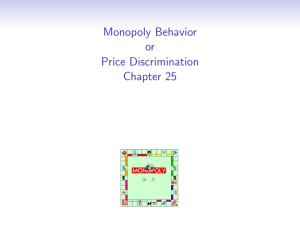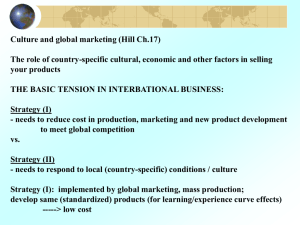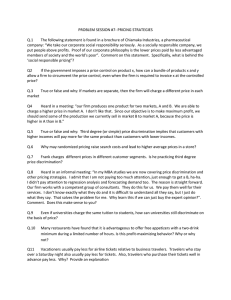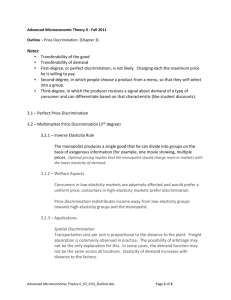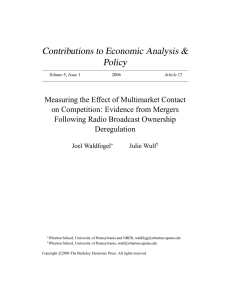Monopoly Behavior or Price Discrimination Chapter 25
advertisement
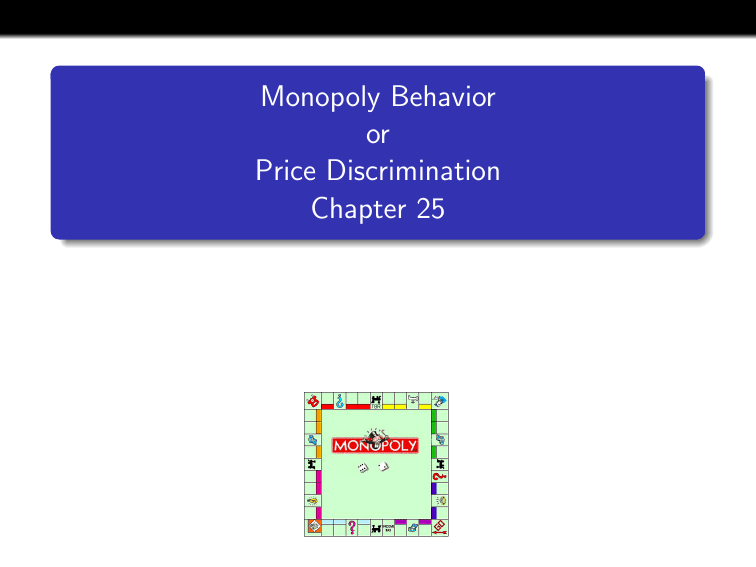
Monopoly Behavior or Price Discrimination Chapter 25 monoply.gif (GIF Image, 289x289 pixels) http://i4.photobucket.com/albums/y144/AlwaysWondering1/monoply.gif?... Monopoly Pricing Uniform pricing: charging the same price to every customer Competitive firms are price takers, suffer losses if they don’t charge the one, uniform market price We’ve been thinking about the behavior of a monopolist charging a uniform price But, a monopolist is a price maker, free to set price, including non-uniformly Today: non-uniform pricing, especially price discrimination Price discrimination: different prices for different people Other non-uniform pricing schemes: two-part tariffs, bundling, tie-ins Non-uniform Pricing Price-discrimination earns a monopoly higher profits Non-discriminating firm faces tradeoff: Charge high price for customers with high WTP Charge low price and sell more units to more customers Optimum typically involves compromise Price-discriminating firm avoids this tradeoff: Charges higher price to those with high WTP capturing their consumer surplus Charges lower price to those with less WTP generating extra sales Example Movie theater, MC = 0: everyone fits, showing movie is costless, so π = revenue Potential audience: 10 college students WTP $10, 20 senior citizens WTP $5 Uniform price = $5 =⇒ π = 5 · 10 + 5 · 20 = 50 + 100 = 150 Uniform price = $10 =⇒ π = 10 · 10 + 10 · 0 = 100 = 100 Price discriminate =⇒ π = 10 · 10 + 5 · 20 = 100 + 100 = 200 Non-uniform Pricing Intuition: why non-uniform pricing works in general Firm faces a profit-maximization problem Uniform prices is one tool to solve the problem Non-uniform pricing allows other, multiple tools This can only help solve the problem, at worst the extra tools are useless and you can choose not to use them Conditions for Price Discrimination Firm has market power Consumers have different demand elasticities, firm can identify them Firm can prevent/limit resales from low-paying to high-paying customers Resales difficult for services, when transaction costs are high E.g. show student ID when buying student software, mail in class schedule Three Types of Price Discrimination Perfect price discrimination (first-degree): sell each unit for consumer’s full reservation price; prices differ across buyers Quantity discrimination (second-degree): different price for larger quantities (bulk discounts); prices same for all buyers Multimarket price discrimination (third-degree): prices same within group, but different groups/markets are charged different prices Perfect Price Discrimination All-knowing monopoly sells each unit at reservation price, height of demand curve Monopolist reaps all possible gains-from-trade, leaves buyers with zero surplus However, monopolist supplies efficient level of output, outcome is Pareto efficient $/output unit PS MC(y) p(y) yc y Quantity Discrimination Hard to determine individual reservation prices But easy to know that most customers are willing to pay more for first unit than second (demand slopes down) Firm varies prices with number of units purchased E.g. utility block pricing, bulk discounts Multimarket Price Discrimination Firm only knows which group/market is likely to have higher reservation prices Different prices for different groups E.g. theater example, airline classes, software pricing, coupons Multimarket Price Discrimination How does the monopolist maximize profits across markets? Choosing price for each market ⇐⇒ choosing quantity for each market π(y1 , y2 ) = p1 (y1 )y1 + p2 (y2 )y2 − c(y1 + y2 ) Profit maximizing condition: MR1 (y1 ) = MR2 (y2 ) = MC (y1 + y2 ) Equate MR across markets to MC If one market generated more marginal revenue than the other, could increase profits be shifting production to that market MR1 (y1 ) = MR2 (y2 ) = MC (y1 + y2 ) Demand differs across markets, so price will be different Where is price higher? In the market with a higher markup Markup = 1 1+ 1 I.e. in market with less elastic demand Multimarket Price Discrimination MR1 (y1 ) = MR2 (y2 ) = MC (y1 + y2 ) Market 1 Market 2 p1(y1) p1(y1*) p2(y2) p2(y2*) MC y1 y1* MR1(y1) MC y2* MR2(y2) y2 Multimarket Price Discrimination Example: workout 25.5 Multimarket Price Discrimination Welfare effects: Inefficient production & consumption Lower welfare than under PC or perfect price discrimination Welfare may be higher or lower than in single-price monopoly Other Kinds of Non-uniform Pricing Two-part tariffs: lump-sum fee + constant price per unit Tie-in sales: can buy one product only if you buy another one as well Requirement tie-in Bundling (or package tie-in) Can think of these as a form of quantity (2nd degree) discrimination, where the average price per unit varies with the number of units purchased Two-part Tariffs Lump-sum fee + per unit price E.g. telephone service (connection fee + per minute rate); club cover charges; NFL personal seat license Because of fixed fee, average price per unit is higher the fewer units you buy Uniform pricing: raise p above MC =⇒ earn more per unit, but lower CS Two-part tariff (ideal): capture each customer’s max potential CS by charging different lump-sum fees, then set p = MC Like with first degree PD, there is no inefficiency But monopolist reaps all gains-from-trade, so equity suffers Tie-in Sales Requirement tie-in: E.g. Printer + ink/toner cartridges, razors + blades Helps firm identify heavy users, i.e. those with high WTP Bundling: E.g. Software such as Microsoft Windows + Internet Explorer, internet & cable service, preseason & regular season tickets, service + parts Allows firms that can’t price discriminate to charge different people different prices Profitability depends on tastes (negatively correlated demand for the two goods) and the ability to prevent resale
